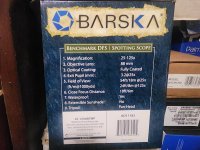Michael Varn
Member

The highest magnification I have ever seen on a spotting scope is 25X-125X.
This includes all spotting scopes regardless of class, price, or brand.
This spotting scope I am referring to is actually a low end Barska model that retailed for a little over $200.00.
All of the top brands like Ziess, Leica, Kowa, and VisionKing that I have seen only go up to 25X-80X.
But these models cost thousands of dollars.
I know there is more to a spotting scope than just magnification, and the lenses on this low end Barska are generic, nothing fancy like diamond coated lenses.
But could someone please explain to me how a spotting scope with a magnification of 25X-125X can be so cheap?
This includes all spotting scopes regardless of class, price, or brand.
This spotting scope I am referring to is actually a low end Barska model that retailed for a little over $200.00.
All of the top brands like Ziess, Leica, Kowa, and VisionKing that I have seen only go up to 25X-80X.
But these models cost thousands of dollars.
I know there is more to a spotting scope than just magnification, and the lenses on this low end Barska are generic, nothing fancy like diamond coated lenses.
But could someone please explain to me how a spotting scope with a magnification of 25X-125X can be so cheap?
Last edited:






